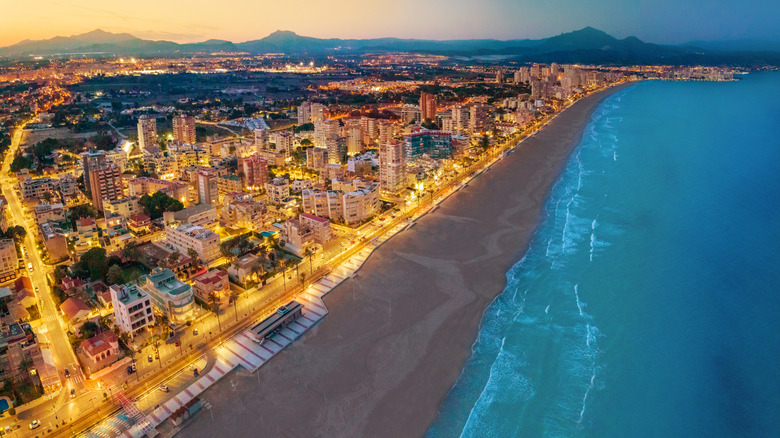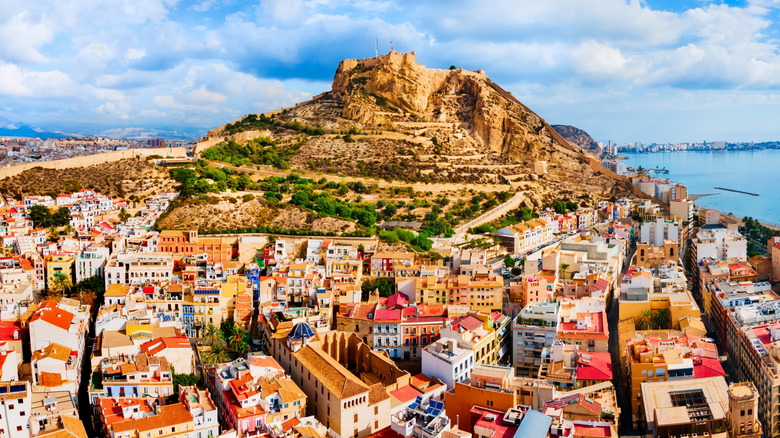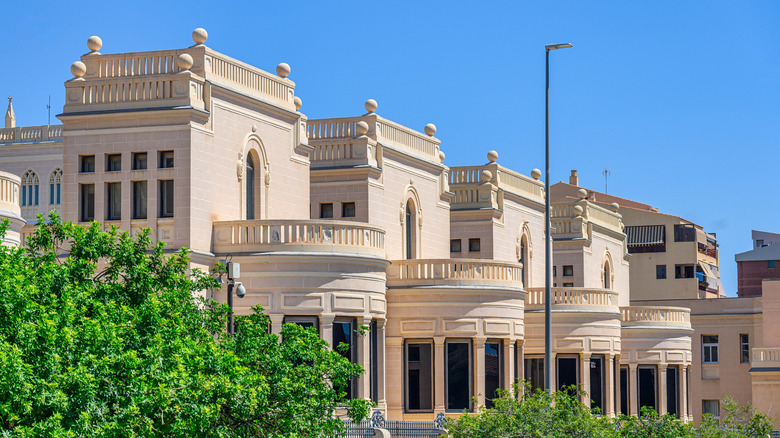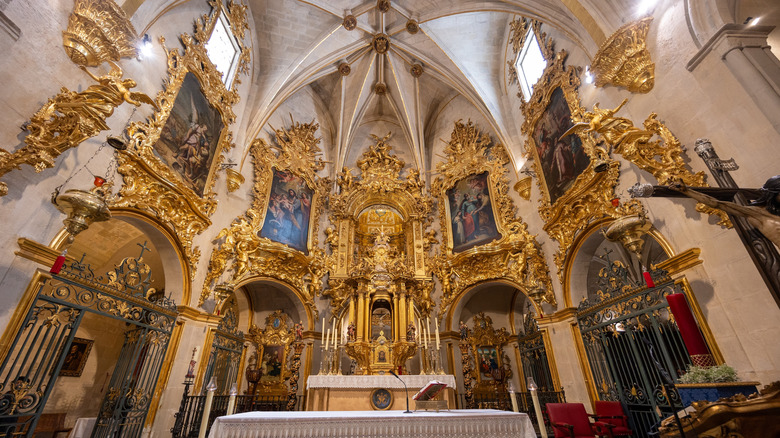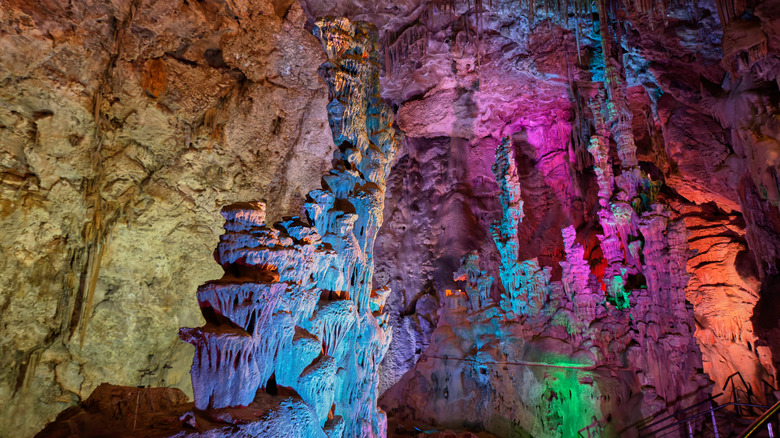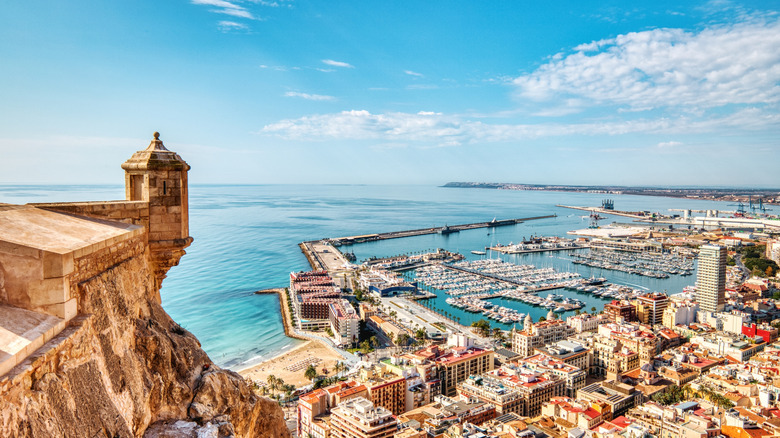Alicante, Spain Offers Plenty Of Amazing Tourist Attractions For Your First Trip
Set on the southeastern coast of Spain, named the best country to retire abroad in 2025, Alicante is an easy city to enjoy from the moment you arrive — offering everything from sandy beaches and a lively waterfront to hilltop fortresses, baroque churches, and neighborhoods with plenty of local character. What stands out most, though, is how simple the city is to navigate. Home to one of the best airports in Europe, Alicante is served by frequent flights from across the continent. After you've touched down, the compact center means you can wander between markets, museums, plazas, and parks with little to no effort. Better yet, there's almost always somewhere nearby to stop for a drink or a bite to eat.
Alicante also excels in the everyday pleasures: fresh seafood, good coffee, a marina made for evening strolls, and a year-round buzz that never feels overwhelming. For first-time visitors, the city strikes an easy balance between beach time, sightseeing, and soaking up the local atmosphere. With its reliable sunshine, coastal setting, historic architecture, and varied attractions, a first trip to Alicante is likely to be a memorable one — especially when you start with the highlights featured here.
Castillo de Santa Bárbara
Towering over the city of Alicante from its lofty vantage point on top of Mount Benacantil, the medieval fortress of Castillo de Santa Bárbara (Santa Barbara Castle) is one of the largest in Spain, and has surveyed the coastline for centuries. Spain is known for its underrated historic gems, and this is undoubtedly one of them — it's not hugely well-known globally, and still an essential stop for anyone visiting the region. Plus, it's also easily accessible, thanks to an elevator that departs from Postiguet Beach and a minibus shuttle service running every 40 minutes from several stops in town. For those who want a more scenic route, a footpath winds its way up, passing viewpoints of the marina, the beach, and the maze of streets below along the way.
Once inside, it's time to explore the castle's main spaces. The Patio de Armas (Weapons Courtyard) is the central open area where daily activity once took place. Meanwhile, the Salón Felipe II (Phillip II Hall) is a well-preserved event space, and the Macho del Castell (Male of the Castle) is the highest tower, offering a stunning 360-degree panorama across the bay.
Want to see more? Free guided tours run daily, and include access to the Old Dungeons, the Old Hospital, and The Renaissance Cistern. From January to late summer, the castle also offers theatrical night tours, where actors lead visitors through various areas while retelling stories from the fortress's history — a memorable after-dark experience.
Explanada de España
Running alongside the marina, the Explanada de España, Alicante's renowned promenade, stands out for its distinctive wave-pattern mosaic created from 6.6 million red, cream, and black tiles. Lined with tall palms, the wide pedestrian walkway links Plaza Puerta del Mar with Parque de Canalejas and stretches for a particularly scenic 1,900-plus feet. Visitors can stroll at an easy pace, stop for ice cream, or browse the many stalls of the Artisan Craft Fair that pops up between July 1 and September 25 every year.
Cafe and cocktail bar Dubliner's sits on the harbor-side of the promenade, making it an ideal place to stop and rest your weary feet while enjoying Spanish tapas and watching the boats bob on the water. Other highlights include Casa Carbonell at the Puerta del Mar end of the promenade — a majestic early-20th-century building with much-photographed white domes that stand out against the blue Spanish sky — and La Concha, an open-air auditorium that hosts concerts and events during the warmer season. Scattered along the walkway, you'll find several sculptures worth pausing to admire, including a tribute to Alicante painter Emilio Varela.
Postiguet Beach
Sitting directly below Castillo de Santa Bárbara and just a short walk from the city center, Postiguet Beach is one of Alicante's most convenient, and in turn most popular, spots to soak up some sun. A wide stretch of sand with calm water, its central location makes it an easy choice for anyone wanting some time by the sea without having to leave the city — which is ideal for tourists without a car at their disposal. Backed by a promenade lined with cafes, shady seating, and play areas for children, this part of the shoreline really has everything you could need for a relaxing beach day.
Lifeguards are on duty during the summer season, making this a solid spot for family swimming, and the showers, toilets, and accessible walkways are another added bonus. Spain is known around the world for having the largest number of sparkling clean beaches, and Postiguet actually holds Blue Flag status — meaning it meets strict EU standards for water quality, safety, and environmental management.
Overall, with its central location and amenities, the beach easily fits into a day out. It's easy to wander between the sand, the marina, and the Explanada, and the area stays buzzing well into the evening as people stroll the promenade enjoying the cooler air.
Barrio de Santa Cruz
For a hit of pure Mediterranean vibes, visitors to Alicante should make a beeline for Barrio de Santa Cruz, one of the city's most distinctive, personality-packed neighborhoods on the lower part of Mount Benacantil. Narrow lanes and steep pathways reveal a riot of brightly painted houses, citrus trees, and charming hidden courtyards, creating an area that feels more like a small hillside village than part of a bustling modern city. Though some parts of the barrio are steep (bring water), the reward is more than worth it — with streets opening up to viewpoints overlooking the old town, the marina, and the sparkling azure of the Mediterranean.
This is the kind of place where there's no need to have a particular destination in mind and to simply wander the beautiful flower-filled streets. That said, there are a few notable spots worth seeking out, such as the Ermita de la Santa Cruz. A white-washed 18th-century chapel, it sits directly next to the Mirador de la Santa Cruz, one of the best lookout points over the old town. This is Spanish culture distilled into one small area, and you could do worse than finding a small cafe and whiling away an hour or two people-watching.
Tabarca Island
The stuff day trip dreams are made of, Tabarca Island — the only inhabited island in the region of Valencia — is one of the most beautiful islands in Spain you've probably never heard of, yet it is located just off the coast of Alicante. Accessible via regular-running boat services from Alicante port, the journey is just an hour long, and the island's compact size makes it easy to explore on foot once you arrive.
With no cars and only a handful of streets, Tabarca Island offers a slower pace than the mainland, along with excellent snorkeling opportunities and a dose of Spanish history. Once a haven for Barbary pirates, the area was transformed in the 18th century when Charles III built a fortified village for Genoese fishing families, and its original walled center is now officially protected for its cultural and historic value.
Despite being just over a mile long, there's plenty to see and do on Tabarca. Stand-out sights include the Church of San Pedro and San Pablo, the 19th-century military building Torre de San José, and the lighthouse on the far end of the island. Meanwhile, the Nueva Tabarca Museum offers an engaging look at the lives of the island's residents throughout history. Tabarca is also home to a Marine Nature Reserve, where the clear, shallow water makes for top-class snorkeling. Take a dip here to spot all kinds of marine life — from groupers and sea bass to white sea bream and even octopus.
Museo Arqueológico Provincial (MARQ)
Better known by its easier-to-pronounce acronym, MARQ, Alicante's Museo Arqueológico Provincial is a treasure trove of archaeological finds in the heart of the city. Housed in a former hospital, MARQ arranges its impressive range of collections around themes and environments, tracing Alicante's development from early hunter-gatherer communities to the modern era. Pottery, jewelry, tools, inscriptions, and everyday household objects illustrate how people in the region lived, worked, worshipped, and traded across the Mediterranean.
The real standout, however, is the museum's set of dedicated rooms with interactive displays that break down field, underwater, and urban archaeology techniques — offering a fascinating look into how discoveries are made, and how many of the objects on display were uncovered. With general admission at just €5 ($5.70 USD) and free entry for children under eight, it's an affordable day out for all ages — and an ideal place to escape the heat while learning something new.
Alicante Marina
The Alicante marina, officially known as the Marina Deportiva de Alicante, is one of the city's most inviting waterfront spots. It sits a short stroll from the old town and right beside the golden sands of Postiguet Beach. A working marina with room for a staggering 740 boats, it doubles as a scenic place to wander, with gleaming yachts, sea views, and the Castillo de Santa Bárbara rising dramatically in the background.
During the day, the promenade is a perfect place to wander, watch sailing crews come and go, or even join the action on the water. In fact, several operators are based in and around the marina, offering sailing trips, catamaran excursions, jet-ski outings, and even parasailing.
As evening arrives, the area transforms into a hub of entertainment and nightlife. Restaurants and cafes open their patios, bars start to fill, and the whole waterfront takes on that holiday-evening feel — perfect for an alfresco dinner or a cocktail while the city's lights reflect on the water. Feeling lucky? The city's Casino Mediterráneo is also located here, featuring roulette, blackjack, poker and more.
Alicante Central Market
Opened way back in 1921, the Mercado Central — or Alicante Central Market — remains a vital part of everyday life for the city's residents. It's also a must-visit for tourists. Located in an impressive and somewhat imposing building, nearly 300 stalls spread across two floors sell all manner of delicious offerings — including fruit, vegetables, meats, herbs, and flowers — to create a bustling scene bursting with color and flavor. This is the perfect place to sample local delicacies too, with tapas, montaditos (a type of small, open-faced sandwich), and the traditional Alicante rice dish of arroz a banda sold at various stalls.
You'll find plenty of locals here for their daily shopping, but it's also the ideal place to pick up authentic and local supplies for a picnic lunch on the beach; heaps of pastries, stacks of Jamón, and wedges of cheese are near-impossible to walk past without reaching for one's wallet. A few small bars are tucked between the stalls, serving coffee, wine, and simple snacks — handy if you want to take a moment and soak up the atmosphere.
La Ereta Park
A scenic green space sprawling over 120 acres in the city, La Ereta Park lies across the hillside between Alicante's old town and the Castillo de Santa Bárbara. This makes the steep climb to the castle even more accessible, providing a lush and shady place to pause along the route while enjoying views of the city below — views that are particularly special at sunset, for obvious reasons.
The park's innovative terraced layout follows the natural contours of the hill, weaving together pathways, lookout points, fountains, and planted gardens to create a peaceful pocket of nature directly above the city. From almost anywhere in La Ereta, you're treated to wide vistas over the marina, the curve of Postiguet Beach, and the tiled rooftops of the old town, firmly securing its place on any "Alicante must-see" list. Even better, the park is home to its own eatery, Restaurante La Ereta, a striking spot with floor-to-ceiling windows and a spacious outdoor terrace. It's one of the best places in the city to sit back with a drink or a meal while soaking up those far-reaching views.
San Nicolás Co-Cathedral
One of Alicante's most important religious buildings, the Concatedral de San Nicolás (Co-Cathedral of San Nicolas) is just a short walk from the old town's narrow streets. Built between the 17th and 18th centuries on the site of a former medieval church, it appears relatively understated from the outside. But don't be fooled, because stepping through its doors reveals a bright and elegant interior situated around a large central dome rising over 140 feet.
Inside, visitors will also find a series of chapels arranged around the nave, including the Chapel of the Holy Communion, often considered one of the most beautiful Baroque chapels in Spain. Stone arches, ornate altarpieces, and quiet alcoves give the building a serene atmosphere, creating a calm respite from the busy streets outside.
While the San Nicolás Co-Cathedral remains an active place of worship, visitors are welcome to come in and explore its architecture between services. The church is generally open daily, with visiting hours usually running from morning to evening, and entry is free. This, paired with its central location just steps from the city's main squares and cafes, makes it an easy and worthwhile stop while wandering through Alicante's historic center.
Plaza del Ayuntamiento
Plaza del Ayuntamiento is one of Alicante's most appealing public spaces, set just behind the waterfront and anchored by the impressive baroque facade of the Ayuntamiento, or Town Hall (pictured). Spacious and open, the square's pale stone paving is calming even during busier moments. It's also an ideal starting point for anyone exploring the city on foot, thanks to its direct link with the old town's maze of narrow streets. The Town Hall itself dates from the 18th century and deserves a closer look: its clock tower, wrought-iron balconies, and ornate stone details are framed by small eateries and shops that spill onto the surrounding edges.
Inside the Ayuntamiento, visitors can view the famous "cota cero" or "zero point," a small marker indicating sea level, alongside a sculpture crafted by none other than Salvador Dalí. The public areas of the building are open to visitors, who can usually walk in freely, though access to certain rooms may depend on tours or scheduled events. The square often provides the backdrop for cultural events, too — from local festivals to outdoor concerts. However, at quieter times it's simply a sunlit space to pause, enjoy a coffee, and watch daily life unfold.
Canelobre Caves
The Canelobre Caves, set in the limestone hills above the small town of Busot, offer one of the most impressive underground experiences in the Alicante region. Formed over millions of years, the caves are best known for their vast main chamber, often compared to a cathedral thanks to its soaring vaults and dramatic rock formations. Guided visits take you along a series of walkways with viewpoints overlooking the cavern floor, giving you a clear sense of the cave's scale — one of the highest vaults of any cave in Spain.
Along the way, you'll hear about the geological forces that created the formations, as well as the cave's unexpected history as a shelter and even a workshop during the Civil War. The caves, being underground as they are, also remain at a cool temperature year-round, making them a popular escape from the region's heat. And considering Spain is one of the sunniest countries in Europe, stepping inside also offers a welcome break from the midday glare. Just a 30-minute (scenic) drive from Alicante, the Canelobre Caves are an essential part of any visit to this region.
Methodology
This selection of attractions was chosen with first-time visitors in mind, focusing on places that are historically important, widely used or valued by locals, visually distinctive, and consistently well-rated or frequently visited by travelers on platforms such as Tripadvisor. To compile the list, we drew on official tourism sources, local destination guides, and wider research into Alicante's history, neighborhoods, and natural highlights.
The aim was to showcase experiences that feel authentic to the region, are easy to access on a typical trip, and reflect what makes the city memorable — from its architecture and viewpoints to its markets, museums, and coastal scenery.
